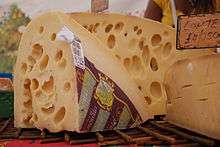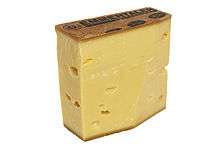Emmental cheese
Emmental (Emmentaler, Emmenthal, or often known as Swiss cheese) is a yellow, medium-hard Swiss cheese that originated in the area around Emmental, in the canton of Bern. It has a savory but mild taste. While the denomination "Emmentaler Switzerland" is protected, "Emmentaler" alone is not: similar cheeses of other origins, especially from France, Bavaria and Finland, are widely available and sold by that name. Emmental was first mentioned in written records in 1293, but first called by its present name in 1542.[1][2]
| Emmental | |
|---|---|
 | |
| Country of origin | Switzerland |
| Region, town | Bern, Emmental |
| Source of milk | Cow |
| Pasteurized | Not traditionally |
| Texture | Medium-hard |
| Aging time | 2–18 months depending on variety |
| Certification | Some varieties |
| Named after | Emmental |
Production
Three types of bacteria are needed to prepare Emmental: Streptococcus thermophilus, Lactobacillus helveticus, and Propionibacterium freudenreichii. Historically, the holes were a sign of imperfection, and until modern times cheese makers would try to avoid them.[3] Emmental cheese is used in a variety of dishes, particularly in gratins, and fondue, where it is mixed with Gruyère.
Protected varieties
Several varieties of Emmental have certification, including:

Switzerland
- Emmentaler Switzerland AOC has been registered since 2000[4] as an appellation d'origine contrôlée (AOC).[5] In 2013, it was replaced by the appellation d'origine protégée (AOP) certification. This original Emmental is produced in small rural dairies with raw cow's milk, adding only natural ingredients (water, salt, natural starter cultures and rennet); preservatives or ingredients from genetically modified organisms are not allowed. The cheese is produced in a round shape with a natural rind, and aged in traditional cellars for a minimum of four months. This Emmental has three age profiles: classic, aged at least four months; reserve, aged at least eight months; and Premier Cru, aged at least fourteen months.
Outside Switzerland
- Allgäuer Emmentaler, from Bavaria, Germany, has PDO status[6]
- Emmental de Savoie, from Savoie, France, has PGI status[7]
- Emmental français est-central from Franche-Comté, France, also has PGI status[8]
References
- Dominik Sauerländer, Anne-Marie Dubler: Käse in German, French and Italian in the online Historical Dictionary of Switzerland, 5 February 2018.
- Ehlers, S.; Hurt, J. (2008). The Complete Idiot's Guide to Cheeses of the World. Complete Idiot's Guide to. Alpha Books. p. 76. ISBN 978-1-59257-714-9. Retrieved May 19, 2016.
- Scientific American Cheese Story August 2010 Pg 33
- "AOC-Label für den Käse mit den grössen Löchern". Swiss Info. 13 September 2004. Retrieved 11 December 2009.
- "Archived copy". Archived from the original on December 11, 2010. Retrieved December 11, 2009.CS1 maint: archived copy as title (link)
- "DOOR". Ec.europa.eu. 1997-01-24. Retrieved 2016-05-14.
- "DOOR". Ec.europa.eu. 1996-06-21. Retrieved 2016-05-14.
- "DOOR". Ec.europa.eu. Retrieved 2016-05-14.
External links
| Wikimedia Commons has media related to Emmental (cheese). |
- Emmentaler in the online Culinary Heritage of Switzerland database.
- Cook's Thesaurus: Semi-Firm Cheeses